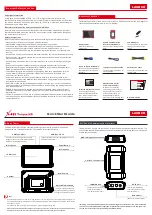
8 | Ottobock
17B97=L16, =R16, =L20, =R20
The end of the lamination joint bar has been profiled to improve anchoring in the fiber compos-
ite material (fig. 2). The sharpened part with the hole (4.2 mm) serves as an attachment to the
17Y106 PVC Profile Bars.
If it is necessary to contour the lamination joint bar over the medial condyles, 100 mm length
joint bars (i.e. 17Y128=16×100) may also be used. A 17Y129 System lamination joint bar with
contoured calf is also available. When completing the orthosis, the system lamination joint bars
should be screwed to the joint connection channels and bonded with 636W18 Ottobock special
adhesive (not included in the delivery). Wait 24 hours for adhesive to set before using the orthosis.
3.3 Profile bar material
After bending the lamination bar around the plaster positive cast (fig. 4), attach the 17Y106
Profile bar material to the lamination bar and the system ankle joint. This foamed PVC profile
bar maintains the proper distance between the reinforcement material and the neutral axis, for
maximum structural strength. Because of its chemical makeup, the surface of the PVC bar can
bond to the orthocryl resin.
Speed rivets attach the PVC bars to the lamination bars (fig. 5). The PVC profile bars may be
thermoformed using a hot air gun at 80 °C/176 °F. A moderate amount of cold forming is also
possible (fig. 6).
3.4 Guide for cable pull-release
To make the cable channel for the perlon cable (2 mm), insert the 21A18=3 guide into the rein-
forcement material, removing it later once the resin has hardened. A hot air gun (180°C/356°F)
can be used to form the guides (fig. 7). The plastic guide will not adhere to the resin. When re-
moving the guide after lamination, the orthosis should remain on the plaster positive cast to make
it easier to pull out. (fig. 8).
3.5 Mounting the perlon cable
Anchor the perlon cable in the locking levers using the threaded sleeve. It can be secured with
636K14 Loctite (optional, if desired.) Pull both perlon cables through the guide channels and con-
nect them with the coupling piece (figs. 9 and 10).
Other connection possibilities include hook & pile closures or plastic closures.
4 Legal information
All legal conditions are subject to the respective national laws of the country of use and may vary
accordingly.
4.1 Liability
The manufacturer will only assume liability if the product is used in accordance with the descrip-
tions and instructions provided in this document. The manufacturer will not assume liability for
damage caused by disregard of this document, particularly due to improper use or unauthorised
modification of the product.
4.2 CE conformity
This product meets the requirements of the European Directive 93 / 42 / EEC for medical devices.
This product has been classified as a class I device according to the classification criteria out-
lined in Annex IX of the directive. The declaration of conformity was therefore created by the
manufacturer with sole responsibility according to Annex VII of the directive.









































